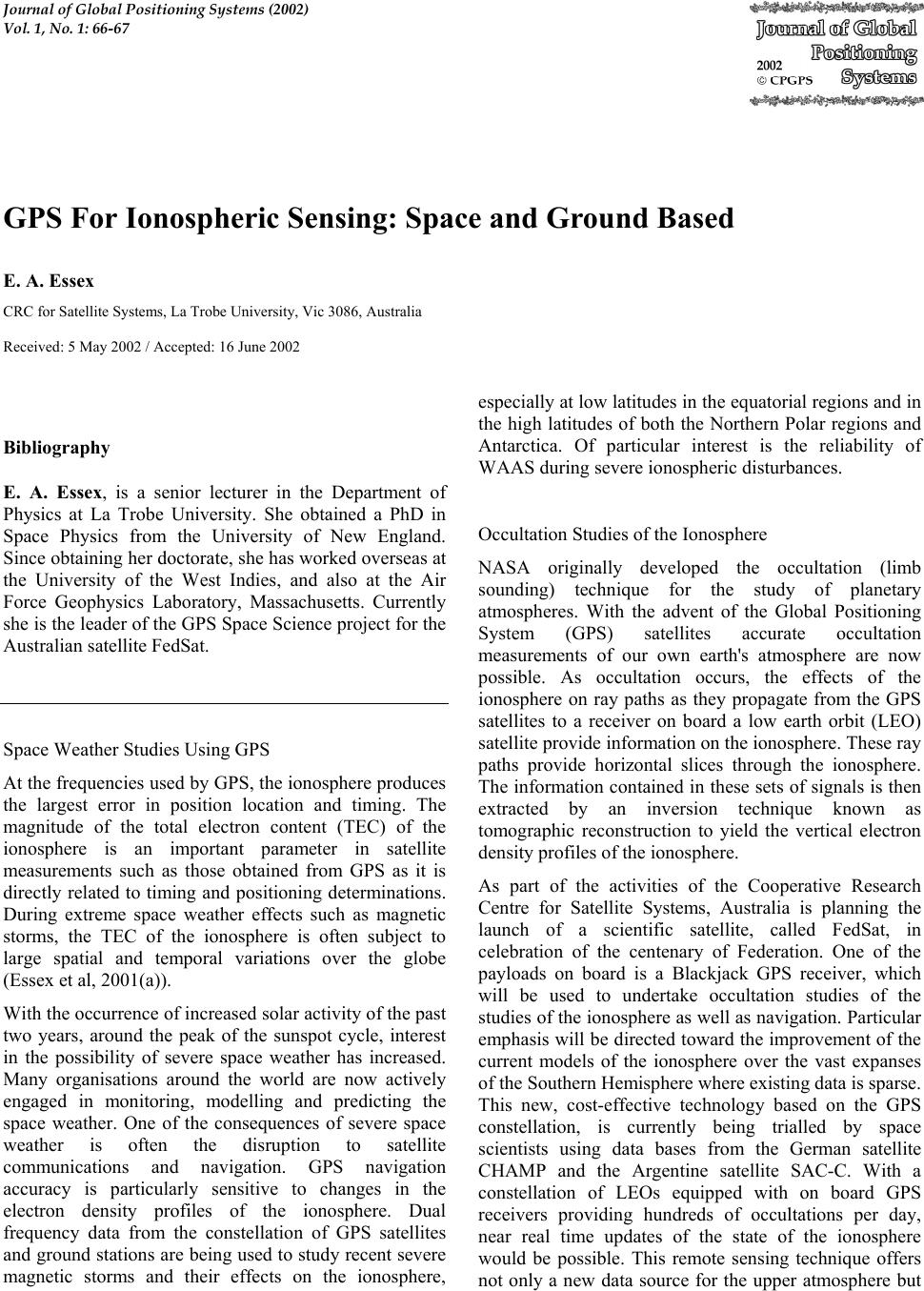Paper Menu >>
Journal Menu >>
 Journal of Global Positioning Systems (2002) Vol. 1, No. 1: 66-67 GPS For Ionospheric Sensing: Space and Ground Based E. A. Essex CRC for Satellite Systems, La Trobe University, Vic 3086, Australia Received: 5 May 2002 / Accepted: 16 June 2002 Bibliography E. A. Essex, is a senior lecturer in the Department of Physics at La Trobe University. She obtained a PhD in Space Physics from the University of New England. Since obtaining her doctorate, she has worked overseas at the University of the West Indies, and also at the Air Force Geophysics Laboratory, Massachusetts. Currently she is the leader of the GPS Space Science project for the Australian satellite FedSat. Space Weather Studies Using GPS At the frequencies used by GPS, the ionosphere produces the largest error in position location and timing. The magnitude of the total electron content (TEC) of the ionosphere is an important parameter in satellite measurements such as those obtained from GPS as it is directly related to timing and positioning determinations. During extreme space weather effects such as magnetic storms, the TEC of the ionosphere is often subject to large spatial and temporal variations over the globe (Essex et al, 2001(a)). With the occurrence of increased solar activity of the past two years, around the peak of the sunspot cycle, interest in the possibility of severe space weather has increased. Many organisations around the world are now actively engaged in monitoring, modelling and predicting the space weather. One of the consequences of severe space weather is often the disruption to satellite communications and navigation. GPS navigation accuracy is particularly sensitive to changes in the electron density profiles of the ionosphere. Dual frequency data from the constellation of GPS satellites and ground stations are being used to study recent severe magnetic storms and their effects on the ionosphere, especially at low latitudes in the equatorial regions and in the high latitudes of both the Northern Polar regions and Antarctica. Of particular interest is the reliability of WAAS during severe ionospheric disturbances. Occultation Studies of the Ionosphere NASA originally developed the occultation (limb sounding) technique for the study of planetary atmospheres. With the advent of the Global Positioning System (GPS) satellites accurate occultation measurements of our own earth's atmosphere are now possible. As occultation occurs, the effects of the ionosphere on ray paths as they propagate from the GPS satellites to a receiver on board a low earth orbit (LEO) satellite provide information on the ionosphere. These ray paths provide horizontal slices through the ionosphere. The information contained in these sets of signals is then extracted by an inversion technique known as tomographic reconstruction to yield the vertical electron density profiles of the ionosphere. As part of the activities of the Cooperative Research Centre for Satellite Systems, Australia is planning the launch of a scientific satellite, called FedSat, in celebration of the centenary of Federation. One of the payloads on board is a Blackjack GPS receiver, which will be used to undertake occultation studies of the studies of the ionosphere as well as navigation. Particular emphasis will be directed toward the improvement of the current models of the ionosphere over the vast expanses of the Southern Hemisphere where existing data is sparse. This new, cost-effective technology based on the GPS constellation, is currently being trialled by space scientists using data bases from the German satellite CHAMP and the Argentine satellite SAC-C. With a constellation of LEOs equipped with on board GPS receivers providing hundreds of occultations per day, near real time updates of the state of the ionosphere would be possible. This remote sensing technique offers not only a new data source for the upper atmosphere but  Essex: GPS For Ionospheric Sensing: Space and Ground Based 67 also may revolutionize the weather forecasting in the lower atmosphere. References Essex, E.A., Birsa, R. Shilo, N.M., Thomas, R.M., Cervera, M.A. and Breed, A.M. Global Positioning System signals under solar maximum conditions, SatNav 2001. Proceedings of the 5th International Symposium on Satellite Navigation Technology and Applications. Eds. K. Kubik and N. Talbot, Canberra, Australia, 24-27July, 2001(a). CDROM. Essex, E.A., Birsa, R. Shilo, N.M., Thomas, R.M., Cervera, M.A. and Breed, A.M. Scintillation effects on Global Positioning Signals under solar maximum conditions, Invited paper. Proceedings of the International Beacon Satellite Symposium. Ed. P. Doherty. Boston, USA, June 4-6, 2001(b). CD Rom |

